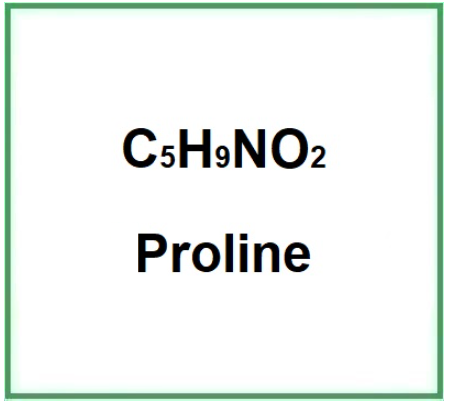Proline is an amino acid ( but it is also labelled as imino acid ) present in the human body, plants and fresh fruit (hydroxy-L-proline). It is considered a non-essential amino acid synthesized from glutamic acid, but is considered an essential component of collagen and for the proper functioning of tendons and joints.
Proline synthesis occurs in the body through a multi-stage process:
- Glutamate conversion: The process begins with the conversion of glutamate into glutamate semialdehyde through the enzyme glutamate 5-kinase and glutamate-5-semialdehyde dehydrogenase.
- P5C formation: Glutamate semialdehyde then spontaneously converts to pyrrolin-5-carboxylate (P5C).
- Reduction to proline: Finally, P5C is reduced to proline by the enzyme pyrrolin-5-carboxylate reductase.
What it is for and where
Medical studies
In contrast to aflatoxins B1 and M1, which are part of a group of secondary metabolites of high toxicity, L-Prolin has demonstrated hepatoprotective activity in laboratory animals by reducing oxidative damage and decreasing downstream apoptosis (1).
The results of this study suggest that l-proline reduces plasma asymmetric dimethylarginine levels and improves redox status, thereby increasing nitric oxide bioavailability and counteracting the angiotensin II-induced Systolic blood pressure rise (2).
L-proline is a cryoprotectant that has no toxicity that helps cells and tissues to resist freezing in a wide range of plants and animals (3).
It's an antibacterial (4) and also chitosan/L-Prolin hydrogels could be a potential dressing material for wound tissue regeneration and repair (5).
Cosmetics
Skin conditioning agent. It is the mainstay of topical skin treatment as it has the function of restoring, increasing or improving skin tolerance to external factors, including melanocyte tolerance. The most important function of the conditioning agent is to prevent skin dehydration, but the subject is rather complex and involves emollients and humectants that can be added in the formulation.
Hair conditioning agent. A significant number of ingredients with specific and targeted purposes may co-exist in hair shampoo formulations: cleansers, conditioners, thickeners, matting agents, sequestering agents, fragrances, preservatives, special additives. However, the indispensable ingredients are the cleansers and conditioners as they are necessary and sufficient for hair cleansing and manageability. The others act as commercial and non-essential auxiliaries such as: appearance, fragrance, colouring, etc. Hair conditioning agents have the task of increasing shine, manageability and volume, and reducing static electricity, especially after treatments such as colouring, ironing, waving, drying and brushing. They are, in practice, dispersants that may contain cationic surfactants, thickeners, emollients, polymers. The typology of hair conditioning agents includes: intensive conditioners, instant conditioners, thickening conditioners, drying conditioners. They can perform their task generally accompanied by other different ingredients.
Proline, what does scientific research says
- Molecular Formula: C5H9NO2
- Molecular Weight: 115.13 g/mol
- CAS: 147-85-3 4305-67-3 37159-97-0
- EC Number: 205-702-2 925-434-6
- FEMA 3319
- DSSTox Substance ID: DTXSID5044021
- Beilstein/REAXYS Number 80810
- MDL number MFCD00064318
- PubChem Substance ID 24898097
- eCl@ss 32160406
- NACRES NA.26
Synonyms:
- (S)-Pyrrolidine-2-carboxylic acid
- (-)-(S)-Proline
- (2S)-pyrrolidine-2-carboxylic acid
- L-Prolin
- 2-pyrrolidinecarboxylic acid
References_____________________________________________________________
(1) l-Proline Alleviates Kidney Injury Caused by AFB1 and AFM1 through Regulating Excessive Apoptosis of Kidney Cells. Li H, Li S, Yang H, Wang Y, Wang J, Zheng N. Toxins (Basel). 2019 Apr 16;11(4). pii: E226. doi: 10.3390/toxins11040226.
(2) l-proline supplementation improves nitric oxide bioavailability and counteracts the blood pressure rise induced by angiotensin II in rats. Leal J, Teixeira-Santos L, Pinho D, Afonso J, Carvalho J, de Lourdes Bastos M, Albino-Teixeira A, Fraga S, Sousa T. Nitric Oxide. 2019 Jan 1;82:1-11. doi: 10.1016/j.niox.2018.10.007.
(3) Cryobiological Characteristics of L-proline in Mammalian Oocyte Cryopreservation. Zhang L, Xue X, Yan J, Yan LY, Jin XH, Zhu XH, He ZZ, Liu J, Li R, Qiao J. Chin Med J (Engl). 2016 Aug 20;129(16):1963-8. doi: 10.4103/0366-6999.187846.
(4) A Thioether-Stabilized d-Proline-l-Proline-Induced β-Hairpin Peptide of Defensin Segment Increases Its Anti-Candida albicans Ability. Zhao B, Yang D, Wong JH, Wang J, Yin C, Zhu Y, Fan S, Ng TB, Xia J, Li Z. Chembiochem. 2016 Aug 3;17(15):1416-20. doi: 10.1002/cbic.201600179.
(5) Biomimetic hydrogel loaded with silk and l-proline for tissue engineering and wound healing applications. Thangavel P, Ramachandran B, Kannan R, Muthuvijayan V. J Biomed Mater Res B Appl Biomater. 2017 Aug;105(6):1401-1408. doi: 10.1002/jbm.b.33675.
(6) The anti-inflammatory effects of N-methyl-(2S,4R)-trans-4-hydroxy-l-proline from Syderoxylon obtusifolium are related to its inhibition of TNF-alpha and inflammatory enzymes. de Aquino PE, Magalhães TR, Nicolau LA, Leal LK, de Aquino NC, Dos Santos SM, Neves KR, Silveira ER, Viana GS. Phytomedicine. 2017 Jan 15;24:14-23. doi: 10.1016/j.phymed.2016.11.010.
![]() Proline
Proline 

